




How to Solve Division Problems Easily
Kids, I hope you have seen your teacher distribute chocolates among your friends so everyone gets the same amount of chocolates. Do you wonder how they know how many chocolates each student should get so that every student can get an equal amount of chocolates? Yes, it is done using division.
Division breaks down a large group into smaller parts. Division can also be separated into two parts, areas, or groups. Every arithmetic operation has its unique symbol. In division, the sign is ‘÷’ or ‘/’ or ‘_’.
For example, we can write,
$\begin{array}{l}20 \div 5 = 4\\\dfrac{{20}}{5} = 4\end{array}$
A decimal point will be added if a smaller value is divided by a larger one. The division is the opposite of multiplication.
What is the Maths Division?
There are four basic arithmetic operations, i.e., addition, subtraction, multiplication, and division. Today, we will discuss division or, to be more precise, 20 divisions. It is when more significant numbers are broken down into smaller groups keeping the number of items constant. In division, there are four main parts.
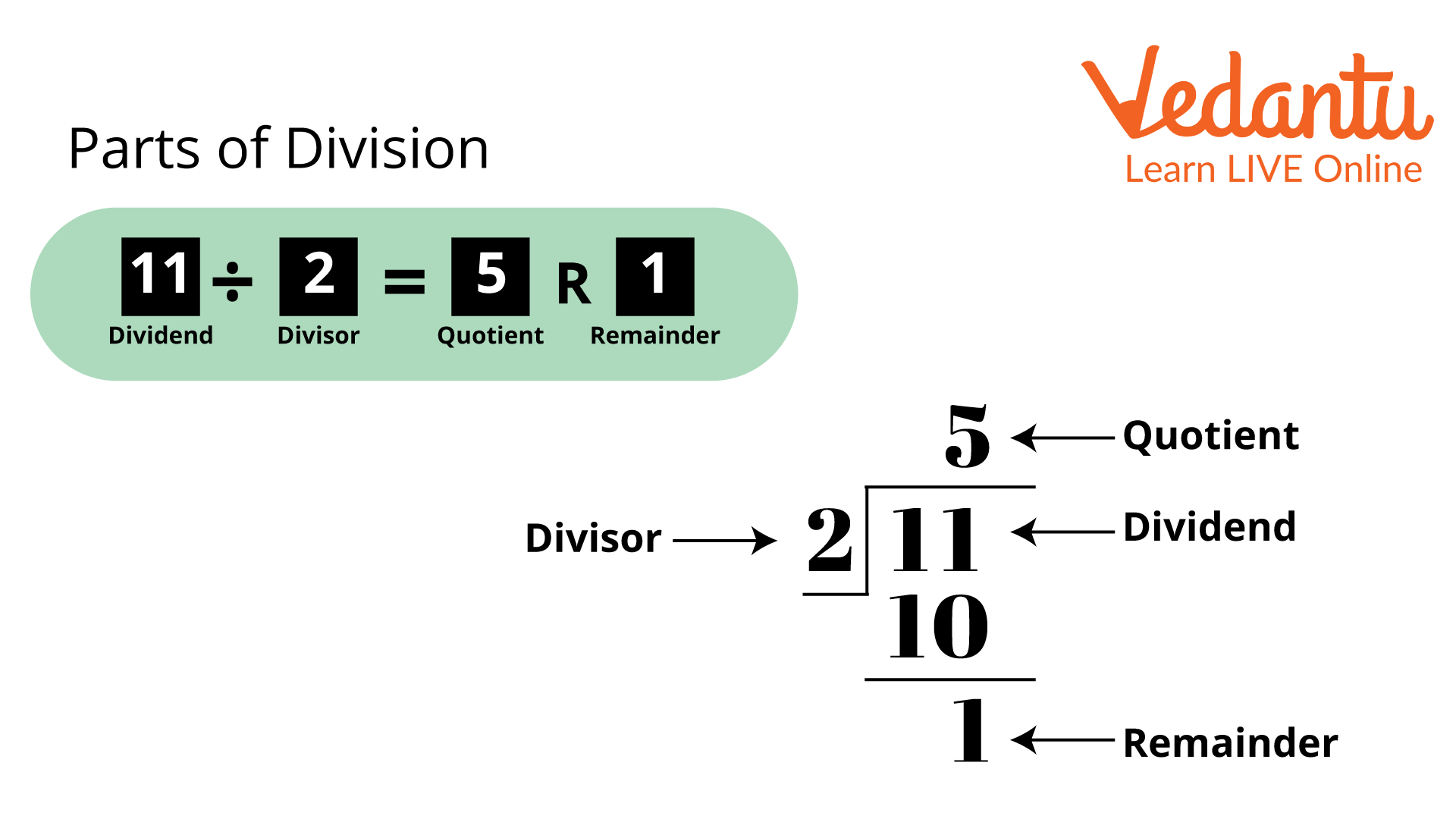
Parts of Division
In this image, as you can see, 11 is divided by 2.
11 is the dividend, 2 is the divisor, 5 is the quotient, and 1 is the remainder.
Formulas to Solve Division
To solve division sums, we need to follow a fundamental yet important formula given below:
∴ $Dividend{\rm{ }} = {\rm{ }}\left( {Divisor{\rm{ }} \times {\rm{ }}Quotient} \right){\rm{ }} + {\rm{ }}Remainder$
This general formula is known as the division formula.
The formula allows us to check the values of the remainder and quotient after division. In the given equation, we can change the quotient, remainder, and divisor values to see if the result and the dividend are the same or fix it otherwise.
How to Solve Division Sums?
Now we will learn how to solve division sum practically.
However, to get a clear view, let us take an example where we will divide 75 by 5.
First, we need to draw the division symbol $\left){\vphantom{1{}}}\right.\!\!\!\!\overline{\,\,\,\vphantom 1{{}}}$ and write the divisor, in this case, it is 5 on the left side, and the dividend is 75 inside the division symbol.
Now take the first digit of the dividend from the left, i.e., 7 and check that number is greater than or equal to the divisor. If it is less than the divisor, then the first two digits of the dividend are considered.
After that, divide it by the divisor, then write the result as the quotient on top. In this case, the quotient of $7 \div 5$ is 1.
Now, subtract the result of the divisor and the quotient's written digit.
Subtract $\left( {5 \times 1} \right)$ from the dividend's first digit, then enter the results. In this case, the difference is 7 - 5 = 2.
Now, if present, we have to write down the next digit of the dividend. The following number is 5.
Repeat the same process until the remainder is less than the divisor.
In division, generally, its quotient is considered as the result.
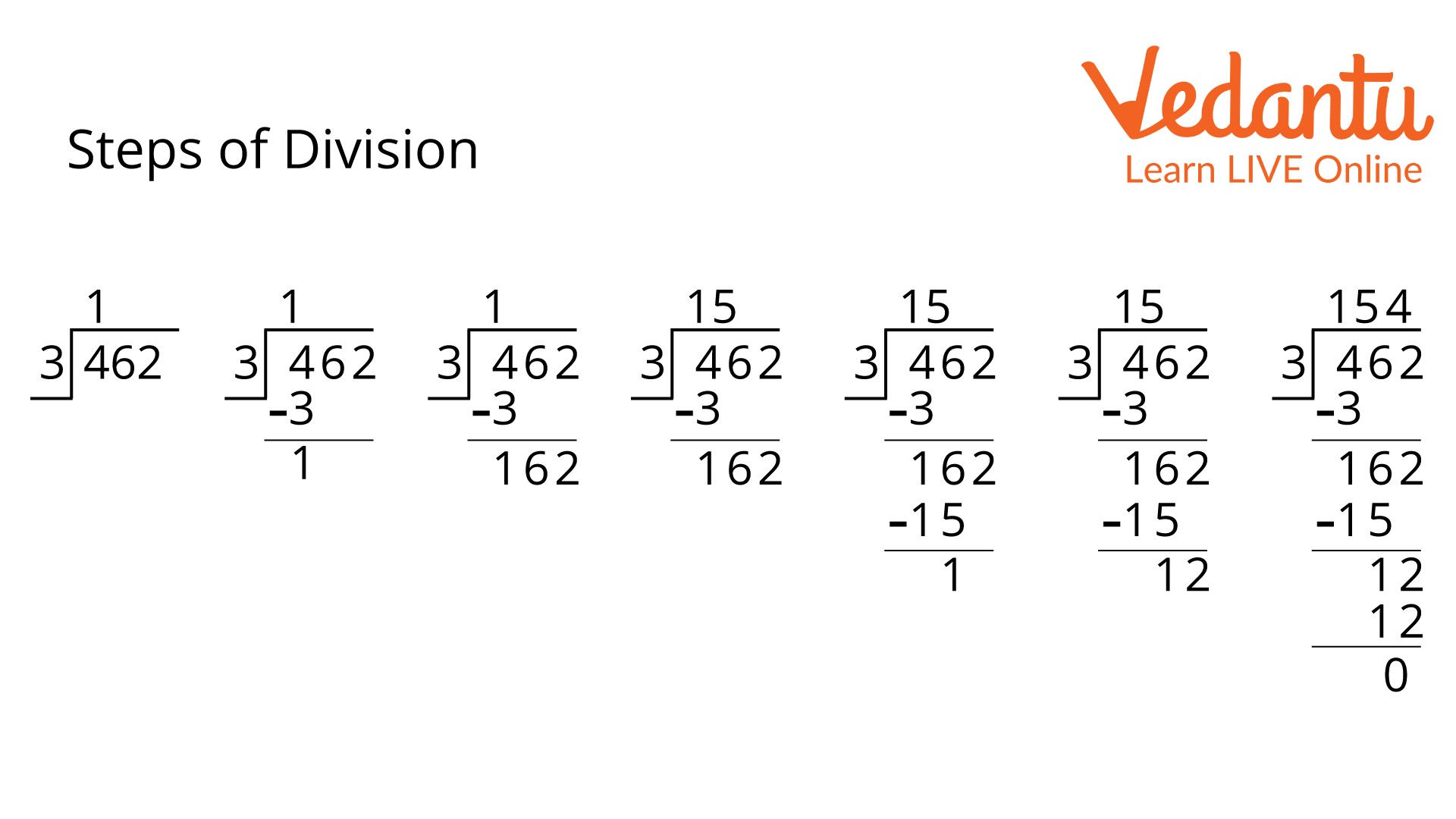
Steps of Division
Division of 20
According to a few basic division rules, one’s digit of 20 is 0. Then it can conclude that it is always divisible by 2 and 5. The divisibility rule of 2 states that if one’s place digit is even, then the number is divisible by 2. Here, the number is 20 and its unit place is 0, so 20 is divisible by 2. And the divisibility rule of 5 states that if the unit place of the number is 0 or 5, then it is divisible by 5. So, here 0 is at the unit place of 20, so, it is divisible by 5.
Division Examples with Answers
For a better understanding of division, let's look at a few examples to understand division better.
Example 1:
Perform the division: 121 and 11.
Solution:
According to question $121 \div 11$.
In the given question, we must know the multiplication table of 11.
Now using the multiplication table, $121 \div 11 = 11$.
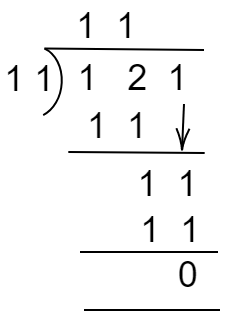
Steps of $121 \div 11$
Therefore, the quotient is 11.
Example 2:
Perform the division: 400 and 20.
Solution:
According to the question, $400{\rm{ }} \div {\rm{ }}20$.
To solve the given question, we must know the multiplication table of 20.
Now using the multiplication table, $400{\rm{ }} \div {\rm{ }}20$.
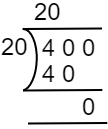
Steps of $400{\rm{ }} \div {\rm{ }}20$
Therefore, the quotient is 20. Example 3:
How many chocolates will each of the kids get if Ria has 20 kids and she buys 80 chocolates for both of them?
Solution:
According to the question, we know the number of kids = is 20 and the number of chocolates = 80.
Thus, the number of chocolates for each kid $ = {\rm{ }}80{\rm{ }} \div {\rm{ }}20$.
To solve the given question, we must know the multiplication table of 20.
Now using the multiplication table, $80{\rm{ }} \div {\rm{ }}20 = 4$.
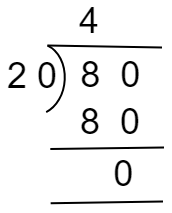
Steps of $80{\rm{ }} \div {\rm{ }}20$
Therefore, the quotient is 4.
Hence, each kid will get 4 chocolates.
Conclusion
After reading the article, it is clear that division requires knowledge of multiplication tables. Working with money is one of the division's most common applications. It can also be used to count everyday items. If we need to divide 10 chocolates between 2 children, we will use the arithmetic process of division.
FAQs on Division in Maths: Definition and Step-by-Step Examples
1. What is division in maths with examples?
In mathematics, division is the process of splitting a number or amount into equal parts or groups. It is one of the four basic arithmetic operations. For example, if you have 12 chocolates to share equally among 4 friends, you would use division to find out how many chocolates each friend gets. The calculation would be 12 ÷ 4 = 3. So, each friend receives 3 chocolates.
2. What are the key terms used in a division problem?
Every division problem has four main components that are related by a specific formula:
- Dividend: The number that is being divided (e.g., in 12 ÷ 4, the dividend is 12).
- Divisor: The number by which the dividend is being divided (e.g., in 12 ÷ 4, the divisor is 4).
- Quotient: The result of the division (e.g., in 12 ÷ 4, the quotient is 3).
- Remainder: The amount 'left over' after the division is complete. If a number divides perfectly, the remainder is 0.
These terms are connected by the division algorithm formula: Dividend = (Divisor × Quotient) + Remainder.
3. How do you perform long division step-by-step?
The long division method is used for dividing large numbers. It follows a sequence of five basic steps that are repeated until the problem is solved:
- Divide: Divide the first digit (or first few digits) of the dividend by the divisor.
- Multiply: Multiply the quotient digit you just found by the divisor.
- Subtract: Subtract the result from the part of the dividend you were working with.
- Bring Down: Bring down the next digit from the dividend to form a new number.
- Repeat: Repeat the process from step 1 with the new number until there are no more digits to bring down.
4. What is the relationship between division and multiplication?
Division and multiplication are inverse operations. This means they undo each other. For every division fact, there is a corresponding multiplication fact. For example, if we know that 20 ÷ 5 = 4, we also know the inverse multiplication fact: 4 × 5 = 20. This relationship is very useful for checking the answer to a division problem.
5. What are the basic properties of division?
Division has several important properties that are essential to understand:
- Dividing by 1: Any number divided by 1 is the number itself (e.g., 15 ÷ 1 = 15).
- Dividing by Itself: Any non-zero number divided by itself is 1 (e.g., 8 ÷ 8 = 1).
- Dividing Zero: Zero divided by any non-zero number is always zero (e.g., 0 ÷ 6 = 0).
- Commutative Property: Division is not commutative, meaning the order of numbers cannot be swapped (e.g., 10 ÷ 2 is not the same as 2 ÷ 10).
6. Why is it impossible to divide a number by zero?
Dividing a number by zero is undefined in mathematics. The reason lies in its relationship with multiplication. If we say that 10 ÷ 0 = x, then according to the inverse relationship, x × 0 must equal 10. However, any number multiplied by zero is always zero, never 10. Since no number can satisfy this condition, the operation is considered impossible or undefined. It represents a logical contradiction.
7. What does the remainder represent when a number does not divide evenly?
The remainder represents the amount 'left over' when one number cannot be perfectly divided by another. It signifies that the dividend is not a whole multiple of the divisor. For example, in the problem 17 ÷ 5, the quotient is 3, and the remainder is 2. This means you can make 3 full groups of 5 from 17, but you will have 2 left over. The remainder is always smaller than the divisor.
8. How is division used in everyday life?
Division is a fundamental skill used in many real-world situations. Some common examples include:
- Sharing Costs: Splitting a restaurant bill or rent equally among friends.
- Cooking: Adjusting a recipe by cutting the ingredients in half or thirds.
- Planning Trips: Calculating fuel efficiency (kilometres per litre) or figuring out how many cars are needed for a group trip.
- Shopping: Comparing prices by calculating the cost per item or per gram to find the best deal.





































